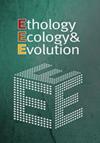新世界灵长类动物的新嗅探:扁鼻猴嗅觉交流研究的最新进展
IF 1.1
4区 生物学
Q4 BEHAVIORAL SCIENCES
引用次数: 2
摘要
本文综述了2006年以来新大陆灵长类(Platyrrhini)嗅觉交流的研究进展,特别是在气味标记方面的研究成果。相对而言,很少有论文专门讨论这个主题,而其他一些论文则包括在解决其他研究问题的研究中收集的相关信息。大多数的论文都是关于富营养液和夜猴的研究。后一项研究的结果反驳了我之前关于性别偏好的气味标记与父亲照顾的相对重要性之间存在联系的假设,但强调了将性选择作为分析嗅觉交流的理论框架的必要性。仅有的两篇论文在领土性和群体间关系的背景下研究了气味标记,拒绝了领土功能,但这仍然是一个有争议的问题。我建议利用栖息地破碎化所产生的准实验条件来解决这个问题。首次采用便携式气相色谱-质谱联用仪检测了野生新大陆灵长类动物嗅觉腺分泌物的化学成分。将这项技术扩展到原位检测气味标记,以及它们的化学特征和信息含量在沉积后如何变化,将是一种很有前途的方法。最后,我建议将Carthey及其同事关于微生物在嗅觉交流中的中介作用的理论框架整合到新大陆灵长类动物气味标记的研究中。本文章由计算机程序翻译,如有差异,请以英文原文为准。
New sniffing at New World primates: recent advances in the study of platyrrhine olfactory communication
This paper reviews the advances made in the study of olfactory communication in New World primates (Platyrrhini) made since the last major review in 2006, particularly the findings on scent-marking. Relatively few papers specifically addressed this topic, and some others include pertinent information collected during studies addressing other research questions. The majority of papers stems from research on callitrichids and night monkeys. Results of the latter studies refute my earlier hypothesis on a link between sex-biased scent marking and the relative importance of paternal care, but emphasize the need for using sexual selection as a theoretical framework for analyzing olfactory communication. The only two papers that examined scent marking in the context of territoriality and intergroup relations rejected a territorial function, but this remains a debated issue. I suggest to exploit the quasi-experimental condition created by habitat fragmentation to address this question. Portable Gas Chromatography-Mass Spectrometry (GC-MS) devices have been employed for the first time to examine the chemical composition of scent-gland secretions of wild New World primates. Expanding this technology to examine scent marks in situ and how their chemical profile and thus information content changes after deposition will be a promising approach for the future. Finally, I propose to integrate the theoretical framework developed by Carthey and co-workerson the role of microbes for the mediation of olfactory communication into studies of New World primate scent marking.
求助全文
通过发布文献求助,成功后即可免费获取论文全文。
去求助
来源期刊

Ethology Ecology & Evolution
生物-动物学
CiteScore
3.10
自引率
0.00%
发文量
44
审稿时长
>12 weeks
期刊介绍:
Ethology Ecology & Evolution is an international peer reviewed journal which publishes original research and review articles on all aspects of animal behaviour, ecology and evolution. Articles should emphasise the significance of the research for understanding the function, ecology, evolution or genetics of behaviour. Contributions are also sought on aspects of ethology, ecology, evolution and genetics relevant to conservation.
Research articles may be in the form of full length papers or short research reports. The Editor encourages the submission of short papers containing critical discussion of current issues in all the above areas. Monograph-length manuscripts on topics of major interest, as well as descriptions of new methods are welcome. A Forum, Letters to Editor and Book Reviews are also included. Special Issues are also occasionally published.
 求助内容:
求助内容: 应助结果提醒方式:
应助结果提醒方式:


